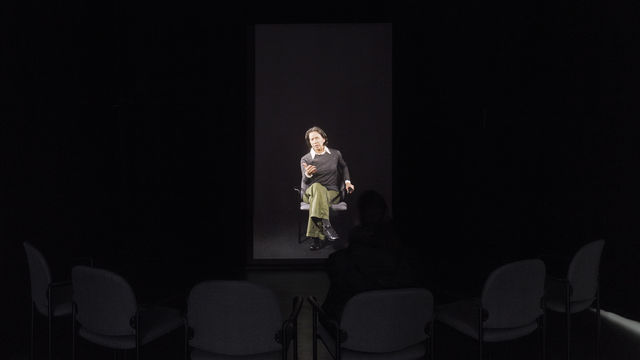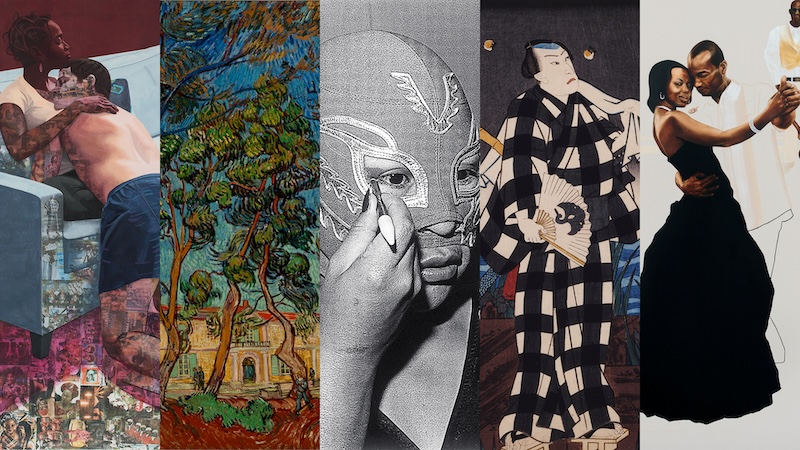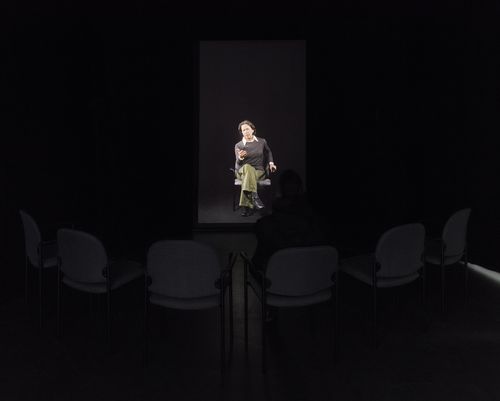
Hammer Projects: Andrea Fraser
- – This is a past exhibition
Since the 1980s Andrea Fraser has achieved renown for performances that interrogate social structures with humor and pathos, aligning herself with feminism and institutional critique. While Fraser’s video and performance works are often associated with investigations of art institutions, her performances since the early 2000s evidence a turn toward analyzing the intersection between sociopolitical and psychological structures as they produce individual and group identity. Representative of this turn is Men on the Line: Men Committed to Feminism, KPFK, 1972 (2012), a video installation that will be on view at the Hammer. For this work Fraser created a script from a little-known Pacifica Radio archival recording of four men articulating their affinities with and support for feminism and women’s rights. Fraser presents this group discussion in a solo performance, adopting mimetic gestures and "masculine" clothing that complicate the institution of gender. Owing to the subtlety of her performance, Fraser displays an affective investment in the anxious exchanges of these male feminists. By embodying the men's struggles with feminism and masculinity, Fraser's sobering reperformance serves as a model for how socially defined identities might forgo their gendered positions so as to enact a politics of care and empathy.
In conjunction with the video installation, the Hammer will premiere a new performance by Fraser in the museum's Billy Wilder Theater exploring the political and cultural polarization of American society.
The Hammer currently owns six of Fraser’s single-channel video works as part of the Hammer Contemporary Collection. Coinciding with the exhibition is the release of Andrea Fraser: Collected Interviews, 1990–2018, a publication coedited by the art historian Rhea Anastas and artists Alejandro Cesarco and Andrea Fraser, and published by A.R.T. Press and Koenig Books, London. The publication presents the artist’s voice in dialogue with interlocutors ranging from professional peers to journalists from the popular media and contextualizes Fraser’s practice in the artistic, institutional, and discursive fields in which she intervenes.
Hammer Projects: Andrea Fraser is organized by Connie Butler, chief curator, with Ikechukwu Onyewuenyi, curatorial assistant.
Biography
Essay
By Ikechukwu Onyewuenyi
To play with mimesis is thus, for a woman, to try to recover the place of her exploitation by discourse, without allowing herself to be simply reduced to it. It means to resubmit herself … to ideas about herself, that are elaborated in/by a masculine logic, but so as to make “visible,” by an effect of playful repetition, what was supposed to remain invisible: the cover-up of a possible operation of the feminine in language. —Luce Irigaray, 1985
We are in a moment—or perhaps an enduring forever—in which patriarchy feels as if it is teetering, suffocating, oddly enough, from its own boisterous tenor. This tone is often aligned with truth (with a capital T), with the masculine voice assumed to be the one brokering certainty, all the while instilling other opinions with self-doubt. The racking surround born of this chauvinism is an offensive that fuels the feminist front. Many in contemporary art circles would say that Andrea Fraser stands at the apogee of feminist and antiestablishment artistic practices. Fraser’s brand of “critique”—or what the artist now considers “institutional analysis”—finds her willingly venturing into the crossfire, fielding fusillades from all angles as well as tallying up her own accounting of matters as broad as the art museum as an institution riddled with exclusionary ideologies and politics (e.g., taste, class, patronage).1 Though Fraser is renowned for her nous in institutional critique, her barbs ultimately land soft, stinging just enough that these same institutions continue to welcome her back into the fray.
Between approximately 1986 and 2001 Fraser lovingly admonished art institutions, returning their invitations with unconventional one-person performances. In Little Frank and His Carp (2001), she situated herself in the lobby of the Guggenheim Museum Bilbao, listening to the official audio guide. Adhering to the edicts of the guide, Fraser’s mimetic engagement spilled into parodic excess as she suggestively gyrated against a limestone pillar. In Kunst muß hängen (Art must hang, 2001), Fraser treated gallerygoers to a reenactment of a drunken speech (in German) that the late artist Martin Kippenberger delivered in 1995 at Club an der Grenze, Austria. In both performances Fraser’s takedown of male personalities—the architect Frank Gehry in the former, the late Kippenberger in the latter—expose broader societal anxieties that fuel the fear of the other festering in art institutions. That both museum and gallery—sites of supposedly progressive cultural production— foster exclusionary and classist ideologies speaks to what Fraser laments as the “unbearable” feeling of continuing to participate in (and critique) activities in the art field.2 Sitting with Fraser’s regret, the performance theorist Shannon Jackson suggests that this “unbearable” engagement with art institutions opened the artist to a “different way to continue” her work on personal terms.3
Fraser herself admits, “Every time we speak of the ‘institution’ as other than ‘us,’ we disavow our role in the creation and perpetuation of its conditions. . . . It is not a question of being against the institution: We are the institution.”4 Along these lines, a shift to analyzing gender roles and stereotypes isn’t that far removed from an analysis of art discourse—artists’ statements and interviews, lectures, wall labels, audio tours— since the production of knowledge across the two institutions is “driven by our own interests.”5
Men on the Line: Men Committed to Feminism, KPFK, 1972 (2012/2014), the video performance on view at the Hammer Museum, marks Fraser’s departure from the art institution proper to consider the psychological dynamics—whether individual or group relations—that color our encounter with art. Here Fraser focuses her analysis on a 1972 live radio recording for KPFK Pacifica featuring a group of four self-identified male feminists. The video installation is a vertical projection presenting a life-size Fraser seated in an unassuming gray office chair. Five similar chairs circle the projection screen, offering a place for viewers to watch Fraser embody the men’s varying relations to feminism. Fraser modulates her speech and body language across the video in marked ways that we begin to witness the mannerisms distinguishing the four men. Fraser’s outfit also plays into the act, with the artist dressing in somewhat masculine or gender-neutral clothing, a kind of lite drag.6 Historical accounts suggest this “trouser role” appearance Fraser takes up emphasized “femininity rather than to mimic maleness.”7 On this basis, by eschewing a convincing mimesis of masculinity, Fraser introduces an element of mimicry that not only troubles the masculine logic underlying the radio conversation, but equally foregrounds the political strivings of feminism.
Conversations of this variety were all too common in the 1970s, with men’s consciousness-raising groups an enactment of that epoch’s countercultural, antipower ethos. The participants in the discussion Fraser reenacts were Lee Christie, Everett Frost (moderator of the conversation), Bob Krueger, and Jeremy Shapiro. Fraser didn’t know much about Christie and Krueger other than that the former was a psychologist and sat on the board of the National Organization for Women. Frost, in contrast, was director of cultural programs at KPFK and married, for some time, to Faith Wilding, a key figure in the Feminist Art Program at Fresno State University and California Institute of the Arts (CalArts). Shapiro taught at CalArts and wrote on the topic of men’s liberation. Fraser stumbled on the recording through Wilding, who alerted her that feminist programs were frequently aired on KPFK.
An even more proximal relationship between Fraser and the recording can be traced via Fraser’s parents, however. For one, the artist’s mother became active in the women’s movement after the family settled in Berkeley in 1967. After Fraser’s parents separated in 1973, her mother came out, and Andrea subsequently grew up in an all-female lesbian feminist household. Moreover, Fraser’s father, a Unitarian minister and philosopher, had an affinity for the antipower orientation of men’s liberation groups. Robert B. Fraser penned an essay in the periodical Progressive World in May 1971 in which he argued that women’s liberation from oppressive gender roles would rescue masculinity from its own limited identity. He also welcomed “ideas about what it means to be just a person.”8 Although Fraser knew the difficulty of getting outside the social institution of gender, he saw purchase in the relational power of “touch” shared between people.9
What does it mean to “touch others . . . inside” and let them “touch us”?10 Fraser negotiates her father’s provocation through the audio transcription process, performance, and eventual video recording of Men on the Line. The act of transcribing spoken language into written words on a page became “very intimate” for Fraser, adding “those words are travelling through me from my ears to my fingertips . . . [as] I make sure to get all of the ‘uh-s’ and the ‘you know-s’ and where people misspeak.”11 Fraser’s process exudes a haptic relationship to time and space that invokes what Stefano Harney and Fred Moten identify as “the touch of the undercommons, the interiority of sentiment, the feel that what is to come is here.”12 Although Fraser figuratively touches the past by performing a broadcast from 1972, Men on the Line also demonstrates an embrace with the now. That is, Fraser’s performance elicits a “the pull of past upon the present” that draws on Elizabeth Freeman’s notion of “temporal drag.”13 When operating out of this drag, Freeman notes that there’s a “stubborn identification” with social positions (e.g., gender) definitive of prior particular histories.14 In the recording, we see this enduring engagement with past when Fraser as Jeremy Shapiro confesses that his “act of categorization . . .tends to narrow” his experiences with just women. Conversely, Fraser admits that what she remembers about people is less their individual/group identities than her relationship with and to them. Alluding to the four men in the recording, she notes, “I’m not ever really performing other people; rather, I’m performing relations to other people, relations that must exist inside of me already, in relationships that I have already internalized.”15 Herein lies the transference of empathy: the men struggling to commiserate with the women in their lives; Fraser attempting to convey this tug-of-war; and Fraser empathizing with the men so as to perform them.
How we understand this grammar of touch and affect is inflected by the movement of Men on the Line from a live performance to one now mediated via video. Fraser remarked that the performance per se isn’t “about the live event. It’s the entire process of creating a work.”16 Fraser began with the history and legacy of the Woman’s Building, the hub of the feminist art movement in Los Angeles in the 1970s, and the framework through which the curator Emi Fontana approached the artist about participating in the performance and public art festival that was part of the Getty’s Pacific Standard Time initiative in 2011–12. While feminism was top of mind for Fontana, she charged Fraser, as well as Vaginal Davis and the late Mike Kelley, to consider contemporary perspectives on gender and queer politics and practice. Poring over videos of the Woman’s Building, Fraser latched onto what many at that time might have considered a “queer” pedagogy of collective artistic practice and consciousness-raising group critiques. If we understand the word queer as simply referring to something unexpected, then it is revelatory, if not radical, to visualize women discussing artistic production in groups and relating it to their social and psychological experiences.
If we take the Woman’s Building as a backdrop to Men on the Line, Fraser’s bodily grammar can be likened to one of mimesis-mimicry, a feminist strategy invested in upending the masculine rhetoric that defines femininity. Her presence as a woman reenacting this boys’ club gathering destabilizes mimesis as truth copied from the dominant male culture. Moreover, since time has not “cured . . . sexism,” as one of the men put it, Fraser’s trouser role performance introduces analogues of womanhood that suggest we view her actions as mimicry—a mimetic relation to the masculine subject that is infused with parody. But Fraser threads a line of empathy that doesn’t fully give into parody, which, in turn, doesn’t completely undermine the authority of the men. Instead, she hangs on their words and cadence, reperforming the men’s every breath, from “the terror” voiced by Everett Frost of being seen as “probably queer” to his “anger expressed against . . . women.” Repeating their logic finds Fraser engaging in a “playful repetition” of mimicry, the type that “make[s] visible . . . what was supposed to remain invisible.”17 This invisibility just so happens to be the fragile posturing of men. Rather than construct a masculine self that relies on the woman’s subordination, Fraser presents a destabilized, vulnerable version of masculinity, one we rarely see today. Fraser’s move to embody this vulnerability as a woman troubles the original recording, all the while underscoring Michael Taussig point in Mimesis and Alterity (1993) that “the wonder of mimesis lies in the copy drawing on the character and power of the original, to the point whereby the representation may even assume that character and that power.”18
The deftness to Men on the Line is how Fraser wields this power. From transcription to (re)performance, Fraser revisits, time and again, what is on the line without ever coming down hard on it. Take her live performance of Men on the Line in 2014 at De Balie, Amsterdam: Fraser opened up the floor for questions afterwards only to evade all queries directed at her qua Andrea Fraser or at her as Everett Frost, the moderator of 1972 broadcast. Fraser doesn’t direct her audiences to any specific judgments or conclusions, leaving them on their lonesome to wrestle with the politics of it all. Even after laying bare their allegiances and anxieties towards feminism, the intellectual positions of the men remain an open question. That said, the denouement to Men on the Line isn’t an impasse per se; but we are left with the melancholy strummings of John Lennon on “Working Class Hero” (1971), which conveys this amorphous questioning of power and the hierarchy of value. In The History of Sexuality, Michael Foucault goes one further, asking what power resides in listening and saying nothing, in questioning and appearing as though not knowing?19 Fraser rides this ambivalence with a “know-it-all persona,” opting to navigate Men on the Line as a ghost of the actual 1972 event—present and absent, almost the same, but not quite.20 Is she a silent spectator? In a way, yes. But through her absence or queer nonpresence, Fraser welcomes an infinite array of meaning, as well as a productive degree of movement or play. In its playfulness, Men on the Line joins with idea espoused by philosopher Jacques Derrida that “play is the disruption of presence,” which is to say a deferral of meaning.21 By all accounts, Fraser defers meaning in Men on the Line, with several critics leaving the performance without “any specific conclusions” or “simple answers,” but still moved enough to cringe, gasp, and think through the dialectic Fraser and her cast of relations play out.
Perhaps this is where Fraser wants us to remain—in an indeterminate space reflecting on the lost history of the men’s liberation movement. Whatever space it is, there will be questions, no doubt, on what might have been, today, had this display of vulnerability caught hold among men. It’s hard to say since the abusive sexism coming to light under the Me Too movement spotlights the failings of ’70s and ’80s—the height of the pro-feminist advocacy. Even with the feminist armature of mimicry, Men on the Line still raises a supposition as to how, as a woman, one might inhabit patriarchy and misogyny in order to best critique it. Fraser is not here to answer that, neither are the bygone men wading through their qualms about second-wave feminism. But there are new conversations we can touch, ones that delve further into the queer fashioning of gender identifications. Through these discussions we might “get outside of ourselves,” as Fraser’s father intuits. The question is are we willing to go there.22
Notes
1. Anne Doran, “‘It’s Important to Be Specific About What We Mean by Change’: A Talk With Andrea Fraser,” ARTNews, December 13, 2016, http://www. artnews.com/2016/12/13/its-important-to-be-specific-about-what-wemean-by-change-a-talk-with-andrea-fraser.
2. Shannon Jackson, “Staging Institutions: Andrea Fraser and the ‘Experiential’ Museum” in Andrea Fraser, ed. Sabine Breitwieser for Museum der Moderne Salzburg (Ostfildern, Germany: Hatje Cantz, 2015), 29.
3. Ibid.
4. Andrea Fraser, “From the Critique of Institutions to an Institution of Critique,” Artforum International 44, no. 1 (September 2005): 105.
5. The clothes Fraser first wore for the Pacific Standard Time premiere of Men on the Line were pulled from her wardrobe. Fraser noted that she didn’t explicitly purchase masculine clothes to produce her drag lite appearance. This outfit ultimately became a uniform.
6. Jack Halberstam, “Drag Kings: Masculinity and Performance,” in Female Masculinity (Durham, NC: Duke University Press, 1998), 233.
7. Robert B. Fraser, “Men’s Liberation—The Inside of the Other Side of Women’s Liberation,” Progressive World 25, no. 3 (May 1971): 14.
8. Ibid., 23.
9. Ibid.
10. Stephanie Cardon, “On the Line: Andrea Fraser discusses the personal and the political,” Big Red & Shiny, February 18, 2013, http://bigredandshiny. org/1599/on-the-line-andrea-fraser-discusses-the-personal-and-thepolitical.
11. Ibid.
12. Stefano Harney and Fred Moten, The Undercommons: Fugitive Planning and Black Study (Brooklyn: Minor Compositions, 2013), 98.
13. Elizabeth Freeman, “Packing History, Count(er)ing Generations,” New Literary History 31, no. 4 (Autumn 2000): 728.
14. Ibid.
15. Cardon, “On the Line.”
16. “Interview with Andrea Fraser,” The George Washington University, https://corcoran.gwu.edu/interview-andrea-fraser.
17. Luce Irigaray, This sex which is not one, trans. Catherine Porter with Carolyn Burke (Ithaca: Cornell University Press, 1985), 76.
18. Michael Taussig, Mimesis and Alterity: A Particular History of the Senses (New York: Routeledge, 1993), xiii.
19. Michael Foucault, The History of Sexuality, Vol. 1: An Introduction, trans. Robert Hurley (New York: Vintage, 1990), 62.
20. Jacqueline Fraser, “Funny Lady,” CCA Wattis Institute for Contemporary Arts, accessed February 3, 2019, https://wattis.org/view?id=6,240,474; Homi Bhabha, “Of Mimicry and Man: The Ambivalence of Colonial Discourse,” October 28 (Spring 1984): 127.
21. Jacques Derrida, Writing and Difference, trans. Alan Bass (Chicago: The University of Chicago Press, 1978), 292
22. Fraser, “Liberation,” 23.
Hammer Projects is presented in memory of Tom Slaughter and with support from the Horace W. Goldsmith Foundation.
Lead funding is provided by Hope Warschaw and John Law and by the Hammer Collective. Generous support is also provided by Susan Bay Nimoy and Leonard Nimoy, with additional support from Good Works Foundation and Laura Donnelley, and the Los Angeles Board of Supervisors through the Los Angeles County Arts Commission.
Hammer Projects: Andrea Fraser is supported by The Kaleta A. Doolin Foundation and Mike Kelley Foundation for the Arts.










